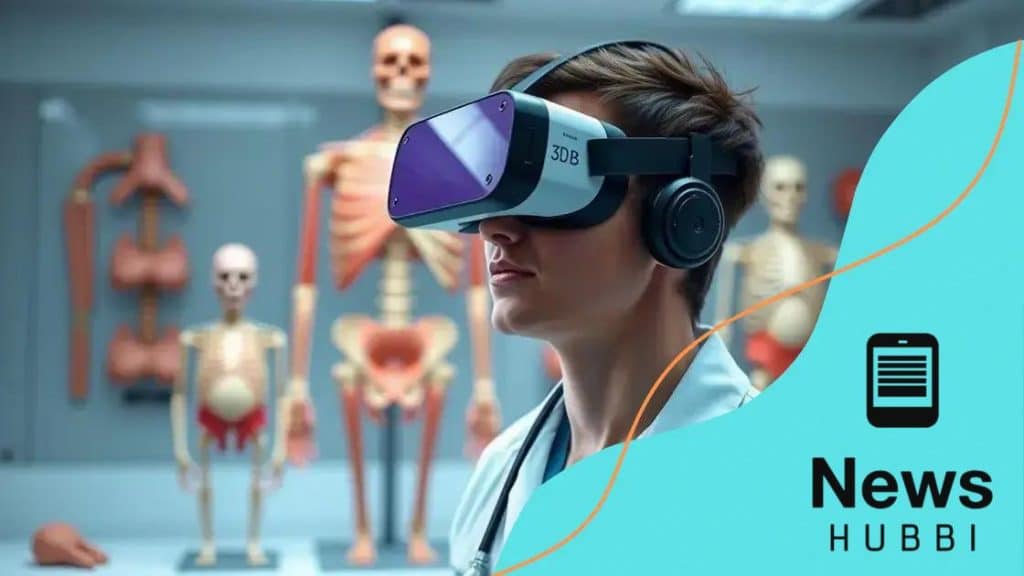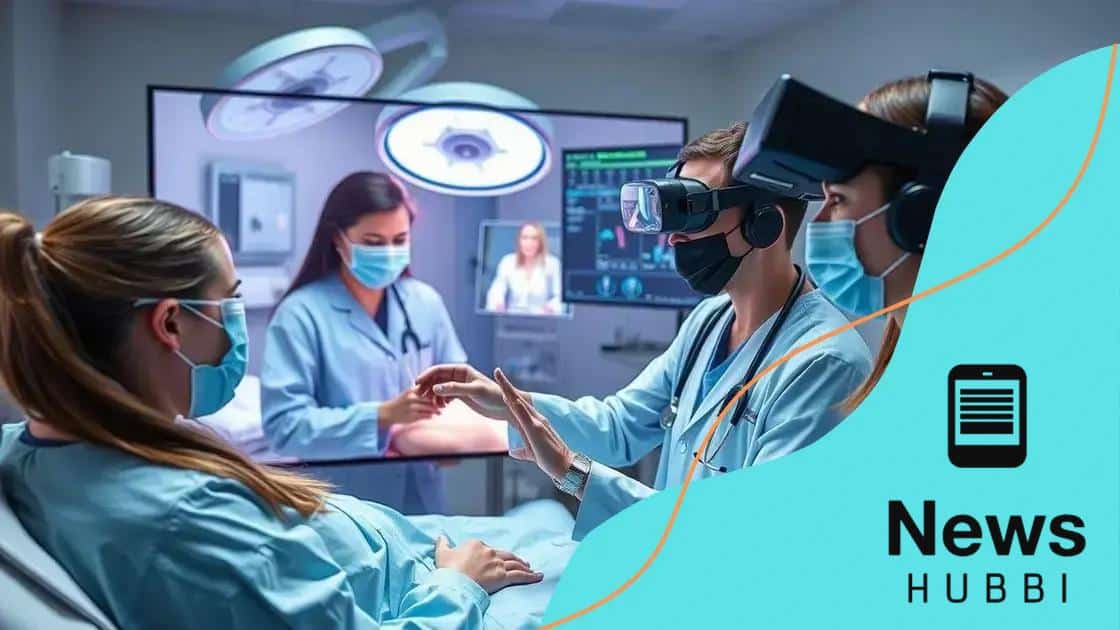How virtual reality is used in medical education

Anúncios
Virtual reality is used in medical education to enhance learning through immersive simulations, interactive experiences, and improved engagement, allowing students to practice skills safely and effectively.
How virtual reality is used in medical education is transforming the way aspiring doctors and healthcare workers learn. Imagine stepping into a 3D operating room without leaving your classroom! This innovative approach not only enhances hands-on experience but also boosts understanding. Let’s delve into this fascinating technology and its applications in training.
Anúncios
The basics of virtual reality
Virtual reality (VR) is an exciting technology that immerses users in a 3D environment. This makes learning more engaging and interactive, especially in fields like medical education. By using VR, students can experience complex medical scenarios without risk. Let’s explore some key aspects of VR.
What is virtual reality?
At its core, virtual reality is a simulated experience that can mimic or differ from the real world. It often involves wearing a headset and using handheld controllers to interact with the environment. The technology responds to your movements, making you feel as if you are truly present in that space.
Key components of VR:
- Headsets: These devices display the virtual world right in front of your eyes.
- Controllers: Handheld devices let you interact with objects and navigate through the VR space.
- Software: This is what creates the virtual environments and scenarios for users.
- Tracking systems: They monitor your movements to enhance the immersive experience.
The impact of VR in education is profound. For medical students, it allows them to practice surgeries or diagnose conditions in a safe environment. This is especially useful for developing critical thinking and decision-making skills.
Anúncios
Moreover, VR technology supports various learning styles. Visual learners benefit from seeing 3D anatomy, while kinesthetic learners engage by manipulating virtual tools. This combination creates a richer educational experience.
As the technology progresses, more educational institutions embrace VR. Not only does it make learning fun, but it also prepares students for real-world challenges by simulating actual medical procedures.
How VR enhances anatomy learning
Understanding anatomy is crucial for medical students, and virtual reality (VR) significantly enhances this learning experience. With VR, students can explore the human body in a way that textbooks cannot offer.
Interactive Learning:
One of the biggest advantages of VR is its interactive nature. Students can manipulate 3D models of organs and systems, making the study of anatomy intuitive and engaging. This interactivity promotes better retention of complex information.
Visualizing Anatomy:
Through VR technology, learners can visualize anatomical structures and their relationships more clearly. For example, they can view the heart’s chambers in real time and understand how blood flows within the organ. This immersive experience builds a strong foundation in anatomy.
Benefits of using VR for anatomy:
- Realistic simulations: Students can practice procedures in a safe environment.
- Enhanced visualization: 3D models provide depth and context that traditional methods lack.
- Personalized pace: Learners can advance through material at a comfortable speed.
- Peer collaboration: VR allows group studies, fostering teamwork and shared insights.
This hands-on approach encourages active learning and promotes a deeper understanding of human anatomy. Studies have shown that students who engage with VR outperform those who rely solely on traditional study techniques. As technology evolves, more medical programs will likely incorporate VR into their curricula.
Through this innovative learning method, students are better prepared for real-life medical scenarios. They attain a level of confidence that is challenging to achieve through conventional learning alone.
Simulating clinical situations with VR

Simulating clinical situations with virtual reality (VR) offers medical students a unique opportunity to practice their skills in a safe environment. This immersive experience allows learners to face realistic scenarios that mimic real-life situations in healthcare.
Realistic Practice:
With VR, students can engage in a variety of clinical tasks, such as diagnosing patients, performing surgeries, and managing emergencies. These simulations provide a hands-on learning experience that is both engaging and informative. The ability to practice repeatedly helps build confidence and competence.
Benefits of VR simulations:
- Safe learning environment: Students can make mistakes without any real-world consequences, fostering experimentation and learning.
- Immediate feedback: Learners receive instant feedback on their performance, allowing for quick adjustments and improvement.
- Enhanced retention: The active involvement in simulations helps improve memory and recall of important concepts.
- Teamwork and communication: VR can replicate team-based scenarios, which emphasize the importance of collaboration in healthcare.
The use of VR in clinical training also prepares students for high-stakes situations they may encounter in their careers. For example, they can practice handling a patient in critical condition, providing the necessary interventions in a controlled space. This reduces anxiety and enhances performance when faced with real patients.
Additionally, the engaging nature of VR makes it easier for students to concentrate and stay motivated. The realistic scenarios stimulate interest, making learning about clinical situations enjoyable.
As technology continues to advance, the integration of VR in medical education is becoming increasingly prevalent. This evolution signifies a shift towards more practical learning methods, better preparing future healthcare professionals for the challenges they will face.
The impact of VR on student engagement
The impact of virtual reality (VR) on student engagement is transforming how medical education is delivered. By creating immersive experiences, VR captures students’ attention and makes learning enjoyable.
Interactive Experiences:
VR offers interactive experiences that traditional methods simply cannot match. Students can participate in 3D simulations of surgical procedures or explore human anatomy in a virtual space. This hands-on involvement keeps learners focused and motivated throughout their studies.
Enhanced Motivation:
When students engage with VR, they often find themselves more motivated to learn. The novelty of the technology sparks interest, leading to deeper exploration of complex medical concepts. Students are excited to log in for their VR sessions, eager to discover new skills.
Benefits of VR on student engagement:
- Increased participation: VR encourages active participation, allowing students to practice skills frequently.
- Improved retention: Interactive content enhances memory retention, making it easier for students to recall information later.
- Realistic scenarios: Experiencing real-world situations helps connect theory to practice, fostering a better understanding of patient care.
- Collaboration: VR promotes collaboration among students, allowing them to work together in virtual environments, enhancing teamwork skills.
The engaging nature of VR enables students to feel more connected to their learning material. With this technology, they can practice not just technical skills but also soft skills like communication and empathy. As a result, students become better prepared to handle real-world challenges in their medical careers.
Moreover, by incorporating feedback mechanisms, VR allows students to understand their strengths and areas for improvement instantly. This immediate feedback loops into the learning process, enhancing student engagement and commitment.
Adopting VR in medical education is not just a trend; it is a significant shift towards more engaging and effective learning methods. As students experience the benefits firsthand, their enthusiasm for learning increases, creating a positive feedback loop that enriches their educational journey.
Future trends in medical VR education
Future trends in medical VR education promise to reshape how students learn and practice medicine. As technology evolves, new advancements are on the horizon, ready to enhance the educational experience.
Integration with AI:
One exciting trend is the integration of artificial intelligence with VR. Imagine a virtual tutor that analyzes a student’s performance and customizes scenarios to fit their learning needs. This means more personalized training, helping students focus on areas where they need improvement.
Enhanced realism:
The next generation of VR systems will likely have improved graphics and haptic feedback. This will create a more immersive environment, making simulations feel even more real. Students will not only see but also feel the interactions, which can significantly enhance their understanding.
Cloud-based VR solutions:
Cloud technology is expected to play a significant role in medical VR education. Storing content in the cloud allows for easier access and collaboration among students and educators. Schools can share resources, allowing students from various institutions to participate in the same training programs.
Benefits of these trends:
- Accessibility: Cloud-based solutions make training available to a broader audience, regardless of location.
- Cost-efficiency: Schools will benefit from reduced costs, as they won’t need to maintain extensive hardware systems.
- Collaborative learning: Students can work together on projects and simulations, enhancing their teamwork skills.
- Data-driven insights: AI will provide instructors with data on student performance, which can inform curriculum development.
As these trends emerge, educational institutions must stay agile, adapting their programs to incorporate new technologies. The future of medical VR education looks bright and promising, opening doors to innovative learning experiences that can prepare students for the challenges of the healthcare field.
Furthermore, with the demand for skilled healthcare professionals increasing, integrating VR education could provide students with the competitive edge they need. They will graduate not only with theoretical knowledge but also practical experience that is deeply relevant to their future careers.
FAQ – Frequently Asked Questions About Virtual Reality in Medical Education
How does virtual reality enhance anatomy learning?
Virtual reality allows students to explore 3D models of the human body, making anatomy learning interactive and engaging.
What benefits do VR simulations offer in clinical training?
VR simulations provide a safe environment for practicing skills, allowing students to make mistakes and learn without real-world consequences.
What future trends can we expect in medical VR education?
Future trends include AI integration, enhanced realism, and cloud-based VR solutions that facilitate more personalized learning.
How can VR improve student engagement in medical programs?
VR makes learning more enjoyable and immersive, leading to increased motivation, participation, and better retention of information.





